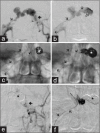Contralateral transvenous approach and embolization with 360° guglielmi detachable coils for the treatment of cavernous sinus dural fistula
- PMID: 25767589
- PMCID: PMC4352642
- DOI: 10.4103/1793-5482.151522
Contralateral transvenous approach and embolization with 360° guglielmi detachable coils for the treatment of cavernous sinus dural fistula
Abstract
carotid-cavernous fistulas are spontaneours acquired connections between the carotid artery and the cavernous cavernous sinus, being classified as direct or indirect; being usually diagnosed in postmenopausal women, but are also associated with other pathoogies such as pregnancy, sinusitis and cavernous sinus thrombosis. They are clinically characterized by ophthalmological symptoms and pulsatile tinnitus. A 51-year-old woman who started her current condition about 4 years ago with pulsatile tinnitus, to which were added progressively: Pain, conjunctival erythema, right eye proptosis and the occasional headache of moderate intensity. Caotid-cavernous fistula wes diagnosed, for the technical difficulty inherent in the case was made a contralateral transvenous approach and embolization with 360° GDG coils, with successful evolution of the patient. The endovascular management of these lesions is currently possible with excellent results.
Keywords: Cavernous sinus; dural fistula; neurointerventional therapy.
Conflict of interest statement
Figures







Similar articles
-
Transvenous embolization of dural carotid cavernous fistula through the facial and ophthalmic vein.Vojnosanit Pregl. 2011 Dec;68(12):1079-83. Vojnosanit Pregl. 2011. PMID: 22352273
-
Transvenous embolization with a combination of detachable coils and Onyx for a complicated cavernous dural arteriovenous fistula.Chin Med J (Engl). 2008 Sep 5;121(17):1651-5. Chin Med J (Engl). 2008. PMID: 19024093
-
Surgical transvenous embolization of a carotid-cavernous dural fistula with cortical drainage via a petrosal vein: two technical case reports.Neurosurgery. 2002 Jun;50(6):1380-3; discussion 1383-4. doi: 10.1097/00006123-200206000-00036. Neurosurgery. 2002. PMID: 12015862
-
[Endovascular management of cavernous sinus dural fistulas].Bol Asoc Med P R. 2014;106(1):17-24. Bol Asoc Med P R. 2014. PMID: 24791359 Review. Spanish.
-
[Dural arteriovenous fistula of the transverse sigmoid sinus after transvenous embolization of the carotid cavernous fistula].No To Shinkei. 1999 Dec;51(12):1065-9. No To Shinkei. 1999. PMID: 10654304 Review. Japanese.
References
-
- Debrun GM, Viñuela F, Fox AJ, Davis KR, Ahn HS. Indications for treatment and classification of 132 carotid-cavernous fistulas. Neurosurgery. 1988;22:285–9. - PubMed
-
- Jacobson BE, Nesbit GM, Ahuja A, Barnwell SL. Traumatic indirect carotid-cavernous fistula: Report of two cases. Neurosurgery. 1996;39:1235–7. - PubMed
-
- Meyers PM, Halbach VV, Dowd CF, Lempert TE, Malek AM, Phatouros CC, et al. Dural carotid cavernous fistula: Definitive endovascular management and long-term follow-up. Am J Ophthalmol. 2002;134:85–92. - PubMed
-
- Yamashita K, Taki W, Nishi S, Sadato A, Nakahara I, Kikuchi H, et al. Transvenous embolization of dural caroticocavernous fistulae: Technical considerations. Neuroradiology. 1993;35:475–9. - PubMed
-
- Higashida RT, Halbach VV, Tsai FY, Norman D, Pribram HF, Mehringer CM, et al. Interventional neurovascular treatment of traumatic carotid and vertebral artery lesions: Results in 234 cases. AJR Am J Roentgenol. 1989;153:577–82. - PubMed
Publication types
LinkOut - more resources
Full Text Sources
Other Literature Sources

